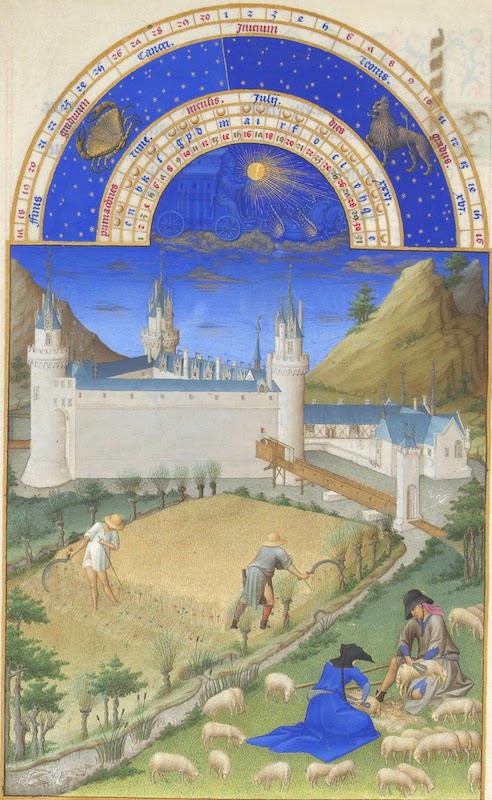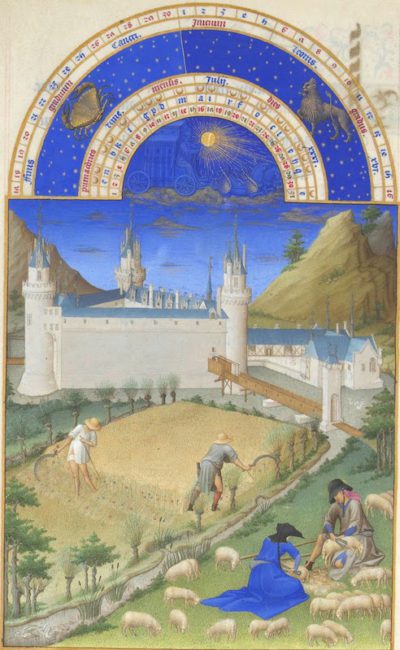
It is commonly believed and asserted by some that there was a Medieval Warm Period. What is true is that in the North Atlantic and the Northern Hemisphere there was indeed a Medieval Warm Period. What is not so well known is that this warming was restricted to just the North Atlantic. It was local to that region. It was not a global warm period. It was also in context not really all that warm when compared to what our fossil fuel emissions are now doing on a global scale.
The Northern Hemisphere
Below is a reconstruction of the Northern hemisphere temperature for the past 2,000 years …
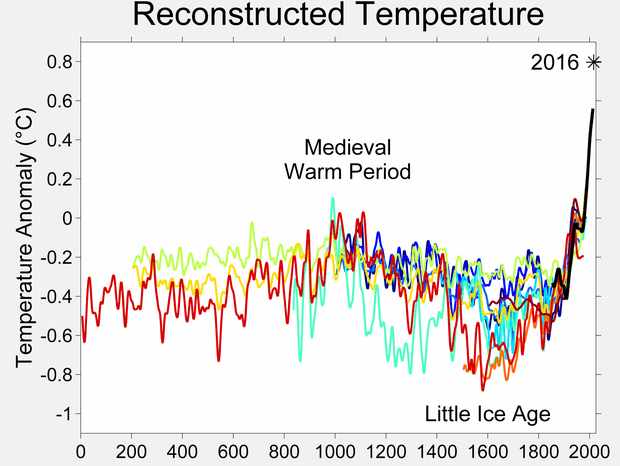
On a Global Scale
Pan out and here is what we find …
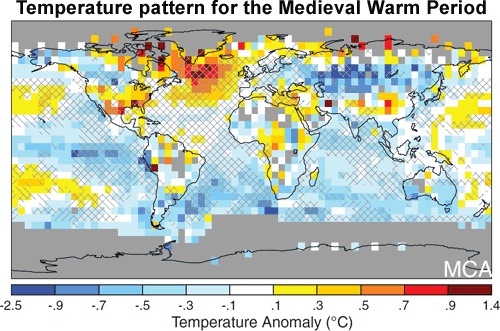
How do we actually know this?
There are several scientific papers that establish what actually happened on a global scale over the last 2,000 years.
One of the most recent is a paper published in July of last year (2019). Titled “No evidence for globally coherent warm and cold periods over the preindustrial Common Era“. The abstract explains …
Here we use global palaeoclimate reconstructions for the past 2,000 years, and find no evidence for preindustrial globally coherent cold and warm epochs.
In particular, we find that the coldest epoch of the last millennium—the putative Little Ice Age—is most likely to have experienced the coldest temperatures during the fifteenth century in the central and eastern Pacific Ocean, during the seventeenth century in northwestern Europe and southeastern North America, and during the mid-nineteenth century over most of the remaining regions. Furthermore, the spatial coherence that does exist over the preindustrial Common Era is consistent with the spatial coherence of stochastic climatic variability. This lack of spatiotemporal coherence indicates that preindustrial forcing was not sufficient to produce globally synchronous extreme temperatures at multidecadal and centennial timescales. By contrast, we find that the warmest period of the past two millennia occurred during the twentieth century for more than 98 per cent of the globe. This provides strong evidence that anthropogenic global warming is not only unparalleled in terms of absolute temperatures5, but also unprecedented in spatial consistency within the context of the past 2,000 years.
Here is a graph from that last paper that illustrates this …
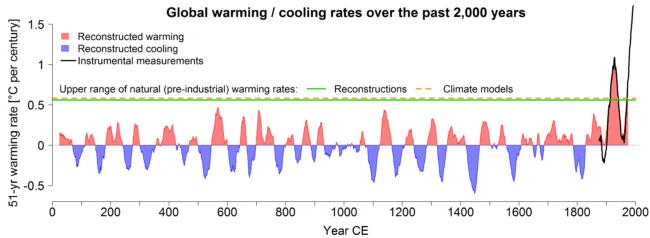
In red are the periods (each across 51 years) in which the reconstructed temperatures increased. Global temperatures decreased in the periods in blue. The green line shows that the maximum expected warming rate without anthropogenic influence is just under 0.6 degrees per century. Climate models (dashed orange line) are able to simulate this natural upper limit very well. At more than 1.7 degrees per century, the current rate of warming is significantly higher than the expected natural rate of warming, and higher than values for every previous century. Instrumental measurements since 1850 (in black) confirm these figures.
But what about the Little Ice Age and Warm Periods?
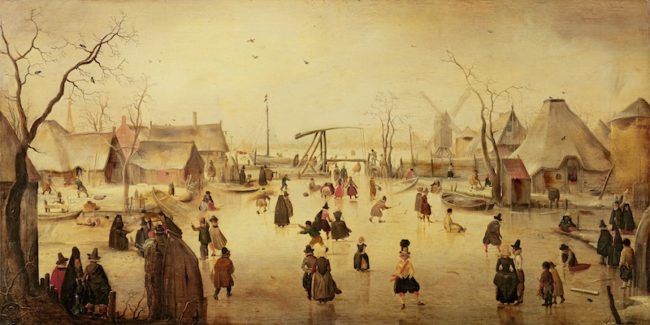
Many people have a clear picture of the “Little Ice Age” (from approx. 1300 to 1850). It is characterized by paintings showing people skating on Dutch canals and glaciers advancing far into the alpine valleys. That it was extraordinarily cool in Europe for several centuries is proven by a large number of temperature reconstructions using tree rings, for example, not just by historical paintings. As there are also similar reconstructions for North America, it was previously assumed that the “Little Ice Age” and the similarly famous “Medieval Warm Period” (approx. 700 – 1400) were global phenomena.
Key Insight: There is no evidence that there were uniform warm and cold periods across the globe over the last 2,000 years.
Climate fluctuations in the past varied from region to region
Raphael Neukom, lead author of the Nature paper …
“It’s true that during the Little Ice Age it was generally colder across the whole world, but not everywhere at the same time. The peak periods of pre-industrial warm and cold periods occurred at different times in different places.”
If the warm and cold phases were not global, then what was going on?
The authors of the study in “Nature” see the explanation for that as being that regional climates in pre-industrial times were primarily influenced by random fluctuations within the climate systems themselves. External factors such as volcanic eruptions or solar activity were not intense enough to cause markedly warm or cold temperatures across the whole world for decades, or even centuries.
It is not just one paper
This prevailing scientific consensus exists for a reason. It is what the best most robust datasets tell us.
- Publication in Nature Goescience by PAGES 2K Consortium: Consistent multidecadal variability in global temperature reconstructions and simulations over the Common Era
- Publication in Nature Goescience by PAGES 2K Consortium: Last phase of the Little Ice Age forced by volcanic eruptions
These studies and others use actual measurements of tree rings, ice cores, lake sediments and corals on a global scale to reconstruct the global climate over the last 2,000 years. Some might indeed promote historical warm and cool periods as “evidence” that what we observe now is part of a natural cycle.
Modern climate change cannot be explained by natural climate fluctuations. Only anthropogenic emissions of CO2 and other greenhouse gases do that. Global temperatures in the 20th century are higher than ever before in at least 2,000 years.
The warming we now observe is impacting the entire planet at the same time. Nothing like this has happened in the past 2,000 years. The speed of global warming today has never been as high as it is today.
Those arguing that this is not the case simply do not have data to backup their claims.
You might have come across the term “Climate Alarmism” being deployed as a derogatory term to mock anybody expressing concern about climate change. To put all this in very simple terms: Shouting “Fire” in a packed theatre turns out to be a really good idea if the building we are in is burning.
Past Warm Period and Ice Age – Further Reading
- Nature (July 2019) – No evidence for globally coherent warm and cold periods over the preindustrial Common Era
- Publication in Nature Goescience by PAGES 2K Consortium: Consistent multidecadal variability in global temperature reconstructions and simulations over the Common Era
- Publication in Nature Goescience by PAGES 2K Consortium: Last phase of the Little Ice Age forced by volcanic eruptions
- PAGES 2K home page
